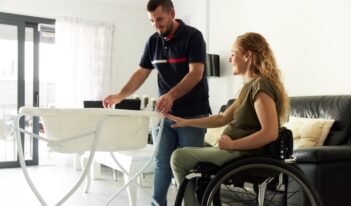
Airline transportation needs to address accessibility issues for passengers with disabilities.
An estimated 25.5 million people—or about 8.5 percent of the U.S. population age 5 and older—have disabilities that make travel outside the home difficult. More than 15 percent of these individuals identify as wheelchair users, including nearly 4 percent who use power wheelchairs. For many of these individuals, a wheelchair is not only an assistive device for mobility but also for other critical medical or physiological functions such as digestive assistance, pressure relief, and stability. As a result, it may be necessary for these individuals to remain seated in their personal, and often customized, wheelchair when traveling.
Most passenger buses and trains are equipped with access and securement systems that allow riders to board the vehicle in their personal wheelchair, stay seated in that wheelchair for the duration of the trip, and then wheel off the vehicle upon reaching the destination. In addition, the Rehabilitation Engineering and Assistive Technology Society of North America has established automobile transportation standards for personal wheelchairs, including for their capacity to protect and restrain the occupant in the event of a motor vehicle crash.
Airline transportation is an exception to this accessibility norm because passenger airplanes do not have reserved spaces for passengers who use wheelchairs or systems for securing a wheelchair. As a result, when people who are nonambulatory fly on an airline, they must be transferred at the gate between their personal wheelchair and an airline-provided boarding chair that can be maneuvered through a narrow aisle. Passengers who cannot perform the transfer themselves must be lifted by traveling companions or service agents into the boarding chair. Once at the seat, the passenger must transfer from the boarding chair to the airline seat. Although some passengers can transfer on their own, others will require assistance. This process is reversed when the passenger deplanes upon arrival.
Passengers subjected to this process can encounter many problems. The multiple transfers can cause strain, discomfort, and, in some cases, injury. Furthermore, some people who have significant disabilities may lack the flexibility, range of motion, physiological ability, or postural stability to sit in a standard passenger seat for even short periods of time, much less a long-distance flight. For others, sitting in a passenger seat can make air travel so uncomfortable and unsafe that they fly rarely, if at all. In addition, many passengers worry that their checked and stowed wheelchair will be mishandled, damaged, or lost. This possibility is worrisome not only because power wheelchairs are expensive and susceptible to damage if mishandled, but also because if an airline loses or damages a wheelchair, the passenger will lose mobility and experience discomfort and pain during the time it takes for the wheelchair to be returned, repaired, or replaced.
In 2021, an expert committee of the National Academies of Sciences, Engineering, and Medicine (NASEM), acting at the request of Congress, issued a report examining the technical feasibility of wheelchair securement systems in passenger airplane cabins. The committee concluded that most wheelchairs, including power wheelchairs, can pass through the main passenger door of the typical passenger airplane. The committee further determined that a wheelchair securement space with ample clearance could be added at the front of the cabin of the most common families of airplanes in the domestic fleet—such as the Boeing 737 and Airbus 320—if the first and second rows of seats are removed. To provide enough room for a wheelchair to maneuver to the cabin aisle, however, the closet that is typically located to the right of the doorway when entering the airplane would need to be downsized or removed.
The report examined a number of other technical and operational issues, including confirming that an airplane’s floor structure should be able handle the loads imparted by a secured power wheelchair. The committee also acknowledged that the displacement of two rows of revenue-generating passenger seats would have economic implications for airlines. Furthermore, airline passengers seated in a secured wheelchair would continue to face the problem of inaccessible lavatories, a problem already faced by current nonambulatory passengers and who must transfer to a standard passenger seat.
A technical matter that proved especially vexing to the NASEM committee concerned the ability of wheelchairs to meet Federal Aviation Administration’s (FAA) standards for passenger seat crashworthiness. Established specifically for the airline operating and crash environments, these standards include a demanding test to demonstrate a seat’s ability to protect the occupant from spinal injury under vertical loadings that could occur from an airplane performing an emergency landing.
The NASEM study presumed that wheelchair manufacturers would need to establish satisfactory wheelchair crashworthiness before FAA would approve the use of systems that secure wheelchairs and use them as seats in airplanes.
It merits pointing out, though, that FAA has a record of granting exemptions from seat crashworthiness criteria. An example is FAA’s approval of an in-cabin medical stretcher installation in 2011. If petitioned to approve requests for an in-cabin wheelchair securement system, it remains unclear whether FAA would require wheelchairs to meet all existing seat criteria or grant an exemption.
Still, very few wheelchairs have been tested in accordance with the FAA crashworthiness test criteria and there are no specific industry safety standards for wheelchairs and their securement in airplane cabins. If required to meet the FAA criteria, wheelchair manufacturers would face a daunting challenge to test and, if necessary, upgrade their models, assuming they could. Meanwhile, the lack of testing experience means that FAA would have little understanding of how any decisions to grant exemptions could affect the safety of wheelchair occupants.
To inform industry and regulatory decision making, the NASEM committee recommended that the U.S. Department of Transportation and FAA establish a research and testing program, in collaboration with the assistive technology industry and the Rehabilitation Engineering and Assistive Technology Society of North America. The program should evaluate an appropriate selection of wheelchairs that meet industry standards to understand how higher-quality wheelchairs would likely perform relative to FAA’s crashworthiness criteria.
Of course, a great deal of additional work would remain before wheelchair securement systems could become a standard feature on airlines. Regulators must ensure that wheelchairs brought on board an airplane are fire resistant and remain crashworthy as they age or if they are modified. In addition, regulators must develop an understanding of the likely travel experience and service needs of passengers who would use the securement systems and assess the implications of any changes on airline operations and economics. Although U.S. Secretary of Transportation Pete Buttigieg has acknowledged the challenges that lie ahead, he has also stressed the importance of meeting them.
At a time when equity is at the forefront of public policy, the continued lack of access to safe, convenient, and comfortable air travel by many people with disabilities is becoming increasingly untenable and will require a concerted strategy to find empathetic solutions.
The authors led the staff efforts to support the NASEM committee whose report is discussed in this essay.
This essay is part of a four-part series entitled, Mobility Justice.





